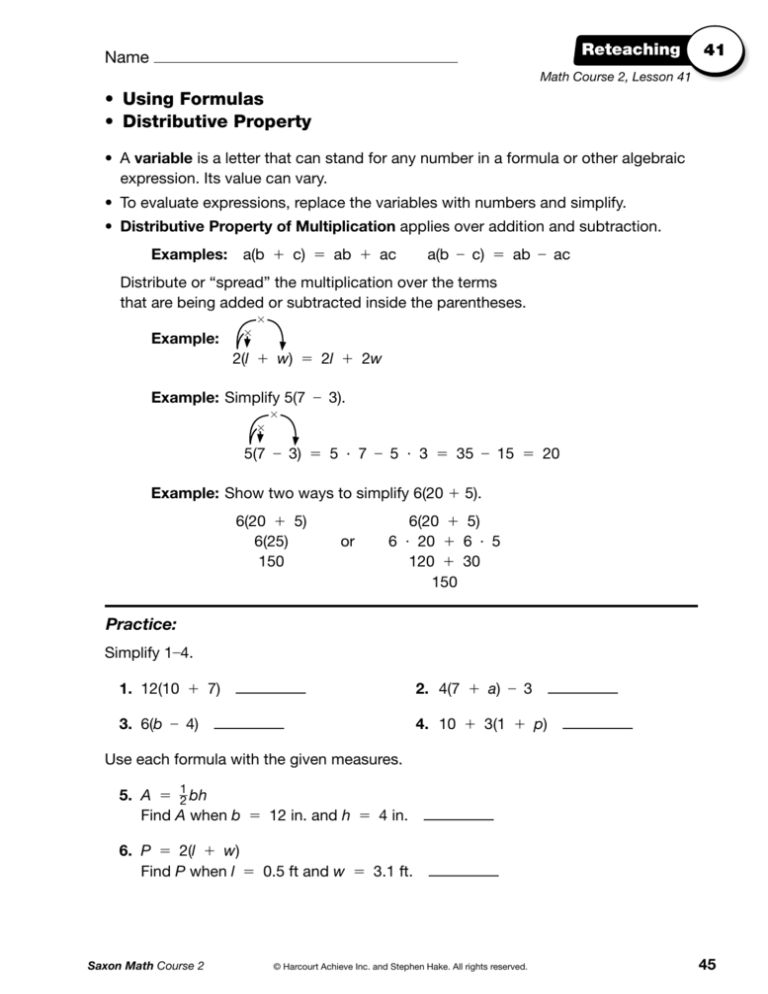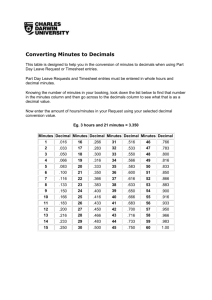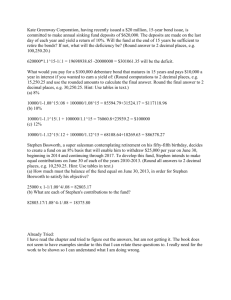
Reteaching
Name
41
Math Course 2, Lesson 41
• Using Formulas
• Distributive Property
• A variable is a letter that can stand for any number in a formula or other algebraic
expression. Its value can vary.
• To evaluate expressions, replace the variables with numbers and simplify.
• Distributive Property of Multiplication applies over addition and subtraction.
Examples: a(b + c) = ab + ac
a(b – c) = ab – ac
Distribute or “spread” the multiplication over the terms
that are being added or subtracted inside the parentheses.
×
Example:
×
2(l + w) = 2l + 2w
Example: Simplify 5(7 – 3).
×
×
5(7 – 3) = 5 · 7 – 5 ⋅ 3 = 35 – 15 = 20
Example: Show two ways to simplify 6(20 + 5).
6(20 + 5)
6(25)
150
or
6(20 + 5)
6 ⋅ 20 + 6 · 5
120 + 30
150
Practice:
Simplify 1–4.
1. 12(10 + 7)
2. 4(7 + a) – 3
3. 6(b – 4)
4. 10 + 3(1 + p)
Use each formula with the given measures.
5. A = __12 bh
Find A when b = 12 in. and h = 4 in.
6. P = 2(l + w)
Find P when l = 0.5 ft and w = 3.1 ft.
Saxon Math Course 2
© Harcourt Achieve Inc. and Stephen Hake. All rights reserved.
45
Reteaching
Name
42
Math Course 2, Lesson 42
• Repeating Decimals
• There are two possible results of decimal division.
1. The division ends with a remainder of zero. It may be necessary to attach
zeros to the dividend in order to continue dividing until it does end. (Be sure
the dividend has a decimal point before attaching zeros.)
3
__
0.375
______
8) 3.000
8
2. The division does not end. Instead there is a pattern of repeating digits. Write
a bar over the first pattern of repeating digits. Repetend is the name for
repeating digits of a decimal number.
Example:
7. 1 6 6 6
_____________
__
43 to a repetend
Examples: Convert ___
6)4 3.10404040... = 7.16
6
• We may choose to round a quotient. To round a repetend:
1. Remove the bar and write the repeating digits.
2. Then round as usual.
____
Example: Round 25.405 to five decimal places.
1. Remove the bar and write the repeating digits.
____
25.405
25.405405...
2. Then round to five places.
2 5. 4 0 5 4 ○
0 5 ...
25.40541
Practice:
1. Write 5.16333... with a bar over the repetend.
____
2. Round 7.284 to the nearest thousandth.
3. Divide 6.7 by 9 and write the quotient with a bar over the repetend.
4. Divide 8.3 by 6 and write the quotient rounded to four decimal places.
46
© Harcourt Achieve Inc. and Stephen Hake. All rights reserved.
Saxon Math Course 2
Reteaching
Name
43
Math Course 2, Lesson 43
• Converting Decimals to Fractions
• Converting Fractions to Decimals
• Converting Percents to Decimals
• To convert decimals to fractions:
1. Write the digits after the decimal point as the numerator.
2. Use the place value of the last digit to write the denominator.
3. Reduce the fraction if possible.
42 = 11 ___
21
Example: 11.42 = 11 ____
100
50
• To convert fractions to decimals:
1. Divide the numerator by the denominator.
2. Write the decimal point and zeros as
necessary.
3. Some fractions convert to repeating
decimals.
4. Show repeating decimals with a bar.
0. 6 6 6...
__________
__
2
2 = 0.6
__
Example: __
3)2. 02020...
3
3
• To convert mixed numbers to
decimals:
1. Whole number does not
change.
2. Divide the numerator by the
denominator.
4 = 3 + __
4
Example: 3 __
5
5
0.8
___
5)4.0
• To convert percents to decimals:
Percents can be written as fractions or decimals.
(Percent means “per hundred” or “hundredths.”)
5 = 0.05
Example: 5% = ____
100
4 = 3.8
3 __
5
Shortcut: Shift decimal point two places to the left.
5%
5%
0.05
Practice:
1. Write 43.75 as a reduced fraction.
11
2. Write __
as a decimal number.
6
3. Write 6.3% as a reduced fraction.
4. Write 148% as a decimal number.
5. Write 4 __12% as a decimal number.
6. Write the product of 6 __23 × 1.25 as a mixed number
Saxon Math Course 2
© Harcourt Achieve Inc. and Stephen Hake. All rights reserved.
47
Reteaching
Name
44
Math Course 2, Lesson 44
• Division Answers
The answer to a division problem with a remainder can be written
in three different ways:
6R3
___
4) 27
• with a remainder
• as a mixed number (with the remainder as a fraction)
0 6. 7 5
_________
• as a decimal number 4) 2 7.3020
3
6 __
4)27
___ 4
remainder
divisor
6.75
A division problem might require continued dividing until there is no remainder or
rounding the answer as instructed.
Example: Round the quotient to the nearest thousandth.
0 4. 1 5 5 5...
_____________
9) 3 7.14505050...
4. 1 5 ○
5 5 ...
4.156
Some division problems require rounding up or down to a whole number.
Example: Fifteen players will travel in vans. Each van carries six players.
a. How many vans are needed? three
b. How many vans will be full? two
Practice:
1. Divide 73 by 4 and write the answer
a. with a remainder.
b. as a mixed number.
c. as a decimal number.
2. Divide 19.6 by 6 and round the answer to three decimal places.
3. One hundred forty-six musicians are seated in rows of fifteen.
a. How many rows of seats are needed?
b. If as many rows are filled as possible,
how many musicians will be in the row that is not full?
48
© Harcourt Achieve Inc. and Stephen Hake. All rights reserved.
Saxon Math Course 2
Reteaching
Name
45
Math Course 2, Lesson 45
• Dividing by a Decimal Number
• To divide by a decimal number:
1. Move the decimal points.
Make the divisor a whole number by moving the decimal point to the right.
(The divisor is the number outside the division box.)
Move the decimal point in the dividend the same number of places to the
right. (The dividend is the number inside the division box.)
Keywords to moving the decimal point are over, over, and up.
Move the decimal point:
over in the divisor (to make a whole number)
over in the dividend (the same number of places as moved in the divisor)
up to the quotient (straight up to the answer)
2. Place a digit in the quotient above each digit of the dividend.
3. Use zero as placeholder.
4. Use short division with one-digit divisors.
_____
Example: 0.06)3.36
____.
Y
006.
)336
. up
over
0 5 6.
______
006.)3 336.
over
Practice:
Simplify 1–4.
1. 0.024 ÷ 0.6
2. 1.4 ÷ 0.8
3. 0.604 ÷ 0.2
4. 1.2 ÷ 0.012
5. Divide 4 by 0.18 and write the answer
rounded to the nearest whole number.
Solve 6 and 7.
6. 0.6x = 35.7
Saxon Math Course 2
7. 5.52 = 2.3t
© Harcourt Achieve Inc. and Stephen Hake. All rights reserved.
49
Reteaching
Name
46
Math Course 2, Lesson 46
• Rates
• Unit price is the cost of one unit of a product.
Example: What is the unit price of a 24-ounce box of cereal that costs $3.60?
1. Multiply the numbers in the loop.
2. Divide by the outside number.
$
3.60 = __
?
_____
Unit price = $0.15 per ounce
ounces
24
1
• Rate is a ratio of two measurements.
Example: Hans pedaled 84 kilometers in 4 hours. What was his average speed?
Use this formula about distance, speed, and time:
distance
distance = rate × time or rate = _________
time
84 km = 21 km/hr
Average speed = ______
4 hr
• Sales tax is the tax charged on items purchased.
1. Multiply the purchase price by the tax rate.
2. Round to the nearest cent.
Example: What is the total cost of an $8.96 item plus 6% sales tax? Find the
amount of sales tax by multiplying $8.96 by 0.06. To find the total
cost, add the $0.54 tax to the $8.96 price.
$8.96 price
× 0.06 tax rate
$0.5376 tax
$8.96 price
+ 0.54 tax (rounded)
$9.50 total
Total cost = $9.50
Practice:
1. Claire’s car averages 25 miles per gallon of gas.
At that rate, how far would it go on 10 gallons?
2. A box of detergent cost $5.12 for 32 ounces. What is the unit price?
3. The price of a radio was $14. The sales tax was 3 __12 %.
What was the total cost including sales tax?
50
© Harcourt Achieve Inc. and Stephen Hake. All rights reserved.
Saxon Math Course 2
Reteaching
Name
47
Math Course 2, Lesson 47
• Powers of 10
• The exponent of a power of 10 tells the number
of zeros in standard form.
Rules of Exponents
(for all powers with the
same base)
Example: 104 = 10,000
• To multiply powers of 10, add the exponents.
ax ⋅ a y = a x + y
ax = ax – y
__
ay
x y
(a ) = axy
Example: 103 × 104 = 103 + 4 = 107
• To divide powers of 10, subtract the exponents.
1014 1013 1012 1011 1010 109 108 107 106 105 104 103 102 101 100
Decimal point
ones
hundreds
tens
Units (Ones)
ones
Thousands
tens
ones
tens
hundreds
Millions
ones
tens
hundreds
Billions
ones
tens
hundreds
Trillions
hundreds
Example: 106 ÷ 102 = 106 – 2 = 104
.
• Powers of 10 are used in expanded notation.
Example: Write 5206 in expanded notation using powers of 10.
(5 × 1000) + (2 × 100) + (6 × 1)
(5 × 103) + (2 × 102) + (6 × 100) (Remember that 100 = 1.)
• To multiply by a positive power of 10:
Shift the decimal point to the right the number of places
shown by the exponent.
Example: 3.14 × 104 = 31,400
4 places
• To divide by a positive power of 10:
Shift the decimal point to the left the number of places
shown by the exponent.
Example: 3.5 ÷ 104 = 0.00035
4 places
Practice:
Solve 1 and 2.
1. 0.238 × 103
2. 1.536 ÷ 102
Write each missing exponent.
3. (106)(102) = 10□
4. (77) ÷ (7□) = 72
5. Write 1294 in expanded notation using powers of 10.
Saxon Math Course 2
© Harcourt Achieve Inc. and Stephen Hake. All rights reserved.
51
Reteaching
Name
48
Math Course 2, Lesson 48
• Fraction-Decimal-Percent Equivalents
• To write a fraction or decimal as a percent, multiply by 100%.
700 = 70%
7 × 100% = ____
Examples: ___
10
10
0.8 × 100% = 80%
• To write a percent as a decimal or fraction, divide by 100%.
60 = 0.6
Examples: 60% ÷ 100% = ____
100
3
60 = __
60% ÷ 100% = ____
5
100
Fraction
Decimal
Percent
1
__
0.5
50%
0.3
30%
4
__
= __2
0.4
40%
Fraction
Decimal
Percent
2
3
__
10
5
10
Practice:
1. Complete the table.
0.2
2
__
3
12%
2. Marie put three fifths of her stamps into an album.
What percent are not in the album?
3. Eduardo traded _16_ of his baseball cards for new ones.
Is that more or less than 0.25 of his cards?
52
© Harcourt Achieve Inc. and Stephen Hake. All rights reserved.
Saxon Math Course 2
Reteaching
Name
49
Math Course 2, Lesson 49
• Adding and Subtracting Mixed Measures
• A mixed measure uses two or more units of the same type of measurement.
• To add mixed measures:
1. Line up matching units.
2. Add like units.
3. Simplify from right to left.
1 yd 2 ft 7 in.
Example:
+ 2 yd 2 ft 8 in.
3 yd 4 ft 15 in.
Simplify: Change 15 in. to 1 ft, 3 in. Add
to the 4 ft. This now makes 3 yd, 5 ft, 3 in.
Change 5 ft to 1 yd, 2 ft. Add to the 3 yd.
This now makes 4 yd, 2 ft, 3 in.
• To subtract mixed measures:
1. Line up matching units.
2. Subtract from right to left.
3. Borrow by converting from one measure to the next.
Example: Subtract 2 yd, 1 ft, 8 in. from 4 yd, 3 in.
2
( 3∕ ft) 15
(3 ft)
3
4∕ yd
3 in.
– 2 yd 1 ft 8 in.
3
4∕ yd
3∕ in.
– 2 yd 1 ft 8 in.
1 yd 1 ft 7 in.
Practice:
Add or subtract 1–4.
1. + 6 hr 29 min 14 sec
+ 1 hr 41 min 12 sec
2. – 11 yd
9 in.
– 10 yd 2 ft 10 in.
3. 6 yd 3 ft 8 in. + 1 ft 9 in.
4. 2 lb 14 oz – 16 oz
Saxon Math Course 2
© Harcourt Achieve Inc. and Stephen Hake. All rights reserved.
53
Reteaching
Name
50
Math Course 2, Lesson 50
• Unit Multipliers and Unit Conversion
• Unit multipliers are ratios (or fractions) with units and are equal to 1.
Example: Write two unit multipliers for these equivalent measures.
3 ft = 1 yd
Write one measure as the numerator and its equivalent as the denominator.
1 yd
3 ft and ____
____
1 yd
3 ft
• Use unit multipliers to convert from one unit of measure to another.
Given
measure
×
Unit
multiplier
=
Converted
measure
Units converting to a given measure are in the numerator.
Units converting from a given measure are in the denominator.
Example: Use a unit multiplier to convert 240 yards to feet.
Problem says change to ft. Use the unit multiplier
that has ft in the numerator.
Cancel matching units and multiply.
3 ft = 720 ft
240 yd ∙ ____
1 yd
Practice:
Use a unit multiplier for each conversion.
1. 7000 grams to kilograms
2. 15 feet to inches
3. 156 ounces to pounds (16 oz = 1 lb)
4. 75 meters to millimeters
5. 325 yards to feet
6. 112 centimeters to meters
54
© Harcourt Achieve Inc. and Stephen Hake. All rights reserved.
Saxon Math Course 2






